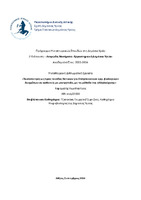| dc.contributor.advisor | Tzanakaki, Georgina | |
| dc.contributor.author | Καραμαλής, Κωνσταντίνος | |
| dc.date.accessioned | 2024-10-01T11:18:17Z | |
| dc.date.available | 2024-10-01T11:18:17Z | |
| dc.date.issued | 2024-09-27 | |
| dc.identifier.uri | https://polynoe.lib.uniwa.gr/xmlui/handle/11400/7523 | |
| dc.identifier.uri | http://dx.doi.org/10.26265/polynoe-7355 | |
| dc.description.abstract | Εισαγωγή. Οι περισσότερες λοιμώξεις από στρεπτόκοκκο στον άνθρωπο οφείλονται στη μετάδοσή του μέσω της άμεσης επαφής με ένα μολυσμένο άτομο και συγκεκριμένα με την έκκριση μολυσμένων σταγονιδίων. Ορισμένοι στρεπτόκοκκοι, που δεν είναι πνευμονιόκοκκοι αλλά ούτε S. pyogenes (GAS) και S. agalactiae (GBS), προκαλούν μηνιγγίτιδα και αναφέρονται στη βιβλιογραφία ως α- αιμολυτικοί στρεπτόκοκκοι, οι οποίοι, αποικίζουν τη στοματική κοιλότητα, όπως για παράδειγμα ο S. mitis. Ιδιαίτερο ενδιαφέρον παρουσιάζουν στρεπτόκοκκοι, όπως ο S. suis, οι οποίοι αποικίζουν τους χοίρους και μεταδίδονται μέσω αυτών αλλά και από την κατανάλωση των παράγωγων προϊόντων χοιρινού κρέατος.
Σκοπός και στόχοι. Σκοπός της παρούσας μελέτης είναι η ανάπτυξη τεχνικής για την ταυτοποίηση ως προς το είδος θετικών για Streptococcus spp. απευθείας σε βιολογικά δείγματα ασθενών με μηνιγγίτιδα/ σηψαιμία, τα οποία δεν έχουν ταυτοποιηθεί ως S. pneumoniae ή ως S. agalactiae (group Β) ή S. pyogenes (group Α). Επιπλέον, η παρούσα εργασία σκοπεύει στη συλλογή πληροφορίας σχετικά με άλλους στρεπτόκοκκους οι οποίοι προκαλούν μηνιγγίτιδα/ σηψαιμία αλλά και στην παρακολούθηση των κρουσμάτων πριν, κατά τη διάρκεια αλλά και μετά την πανδημία της νόσου COVID- 19.
Υλικό και μέθοδος. Αποτέλεσαν δείγματα DNA θετικά για Streptococcus spp. από ασθενείς με μηνιγγίτιδα/ σηψαιμία τα οποία δεν είχαν ταυτοποιηθεί ως S. pneumoniae, S. agalactiae (B) και S. pyogenes (Α). Εφαρμόστηκε η μέθοδος της PCR για την ενίσχυση του γονιδίου tuf απευθείας στα κλινικά δείγματα και αλληλούχιση του προϊόντος. Τέλος, έγινε επεξεργασία των αποτελεσμάτων της αλληλούχισης καθώς και σύγκριση τους με αλληλουχίες αναφοράς με το BLAST.
Αποτελέσματα. Χρησιμοποιώντας το γονίδιο tuf για την ταυτοποίηση των στρεπτόκοκκων, βρέθηκε ότι μέχρι στιγμής το μεγαλύτερο ποσοστό στρεπτόκοκκων που έχουν προκαλέσει μηνιγγίτιδα αλλά και σηψαιμία είναι στρεπτόκοκκοι που ανήκουν στην ομάδα των S. mitis. Ειδικότερα, τα αποτελέσματα της αλληλούχισης έδειξαν ότι η πλειονότητα των δειγμάτων σχετίζονταν με τα είδη των S. mitis/ pseudopneumoniae και S. salivarius.
Συμπεράσματα. Το συγκεκριμένο γονίδιο αποτελεί τον κατάλληλο μοριακό δείκτη για τις φυλογενετικές αναλύσεις και την περαιτέρω ταυτοποίηση των στρεπτόκοκκων απευθείας σε κλινικά δείγματα καθώς εμφανίζει ισχυρότερη διακριτική ισχύ συγκριτικά με τα υπόλοιπα γονίδια. Η παρούσα μεθοδολογία αποκάλυψε πληροφορία σχετικά με τα είδη άλλων στρεπτόκοκκων, ιδιαίτερα σε κλινικά δείγματα με αρνητική καλλιέργεια | el |
| dc.format.extent | 124 | el |
| dc.language.iso | el | el |
| dc.publisher | Πανεπιστήμιο Δυτικής Αττικής | el |
| dc.rights | Αναφορά Δημιουργού - Μη Εμπορική Χρήση - Παρόμοια Διανομή 4.0 Διεθνές | * |
| dc.rights | Attribution-NonCommercial-NoDerivatives 4.0 Διεθνές | * |
| dc.rights.uri | http://creativecommons.org/licenses/by-nc-nd/4.0/ | * |
| dc.subject | Μηνιγγίτιδα | el |
| dc.subject | Στρεπτόκοκκοι | el |
| dc.subject | Σηψαιμία | el |
| dc.subject | Αλληλούχιση | el |
| dc.subject | Λοιμώξεις | el |
| dc.subject | Streptococcal infections | el |
| dc.subject | Meningitis | el |
| dc.subject | Sepsis | el |
| dc.subject | Patients | el |
| dc.subject | Public health | el |
| dc.title | Ταυτοποίηση ως προς το είδος θετικών για Streptococcus spp. βιολογικών δειγμάτων σε ασθενείς με μηνιγγίτιδα, με τη μέθοδο της αλληλούχισης | el |
| dc.title.alternative | Identification of Streptococcus spp. in positive biological samples from patients with meningitis, using the sequencing method | el |
| dc.type | Μεταπτυχιακή διπλωματική εργασία | el |
| dc.contributor.committee | Ξηρογιάννη, Αθανασία | |
| dc.contributor.committee | PATSOULA, ELENI | |
| dc.contributor.committee | Ξηρογιάννη, Αθανασία | |
| dc.contributor.faculty | Σχολή Δημόσιας Υγείας | el |
| dc.contributor.department | Τμήμα Πολιτικών Δημόσιας Υγείας | el |
| dc.contributor.master | Δημόσιας Υγείας | el |
| dc.description.abstracttranslated | Introduction. Most human streptococcal infections are caused by transmission of Streptococcus spp. through direct contact with an infected person and specifically through infected secretion droplets. Some streptococci, which are not S. pneumoniae, neither (S. pygoenes) nor GBS (S. agalactiae), cause meningitis and are described as α-haemolytic streptococci, such as S. mitis, colonize the oral cavity. Moreover, some streptococci such as S. suis, colonize pigs and are transmitted through direct contact woth them as well as from the consumption of their derived products.
Aim. This study aims to the development of a technique for the identification of Streptococcus spp. directly in biological samples from patients who had meningitis/septicemia, and have not been identified as S. pneumoniae or as S. agalactiae (group B) or S. pyogenes (group A). In addition, the present study aims to collect information about other streptococci that cause meningitis/septicemia and to monitor the cases trendline before, during and after the COVID- 19 pandemic.
Material and methods. Positive for Streptococcus spp. DNA samples from patients with meningitis/septicemia that had not been identified as S. pneumoniae, S. agalactiae (B) and S. pyogenes (A). The PCR method was applied to amplify the tuf gene directly in the clinical samples and sequence the product. Finally, the sequencing results were processed and compared in BLAST with reference sequences.
Results. With the use of the tuf gene in the identification of Streptococcus spp., it was found that the largest percentage of streptococci that have caused meningitis and septicemia, are Streptococci spp. belonging to the S. mitis group. In particular, the sequencing results showed that the majority of the samples were related to the species of S. mitis/ pseudopneumoniae and S. salivarius.
Conclusions. This specific gene is the appropriate molecular marker for phylogenetic analyses and for the further identification of streptococci directly in clinical samples due to its stronger discriminatory power compared to the other genes. The present methodology revealed information about the species of other streptococci group, especially in the absence of bacterial strains. | el |


